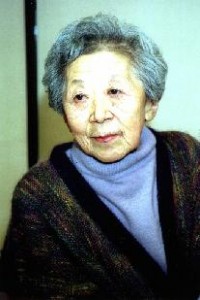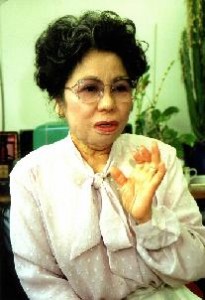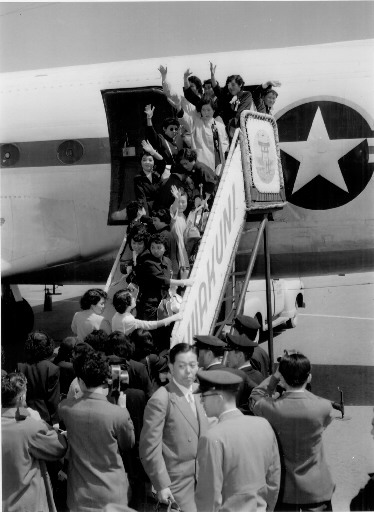History of Hiroshima: 1945-1995 (Part 6, Article 2)
Aug. 1, 2012
Hiroshima Maidens
by Masami Nishimoto, Staff Writer
Note: This article was originally published in 1995.
The atomic bombing not only stole away the lives of so many in an instant, it also forced the survivors to endure difficult lives from that point forward. After the war, orphans and young women, in particular, were plagued with days of hardship. Even after many citizens of Hiroshima were able to find peaceful lives, the atomic bombing weighed heavily on such survivors. As the years passed, most of the orphans and young women, who were beset by severe mental and physical scars and adversities, became tight-lipped in the face of the thoughtless stares of the public.
“What difference will it make if I talk about it now, after all these years?” “I’m fed up with the atomic bombing and the media.” When I came into contact with those who were once called “A-bombed orphans” and “A-bomb Maidens,” a striking number of them refused my request for an interview. Even 50 years after the atomic bombing, the lingering wounds in their hearts have not healed. Under these circumstances, the Chugoku Shimbun took up the task of tracking the life of an orphan who twice survived the ravages of war, in Japan and South Korea, and the “Hiroshima Girls,” who traveled to the United States to receive medical treatment for their keloid scars. This report was motivated by our abhorrence of war and the atomic bombing, which have brought misery to the most vulnerable.
Hatsuko Yokoyama watches over “Hiroshima Maidens”
Among the victims of the atomic bomb’s merciless heat rays, which seared the flesh at up to 4,000 degrees Celsius, were young women. These burns left scars that were hard to remove and lingered on their bodies. The resulting keloids--scars raised on the skin--and the rude stares that ensued from the people around them stripped these women of their smiles and numbed their hearts.
In 1955, ten years after the atomic bombing, 25 single women from Hiroshima traveled to the United States to undergo medical treatment for their keloid scars. The expression “Hiroshima Maidens” came to refer mainly to these women.
The scarred bodies of the “Hiroshima Girls,” as they were dubbed in the United States, prompted questions among the American public about the terrible reality of the atomic bombing. At home, they stirred calls for relief measures for A-bomb survivors and spurred the enactment of the Atomic Bomb Medical Relief Law in 1956. Through a series of interviews with these women, I learned about a person that they came to revere.
Her name is Hatsuko Yokoyama, now 85, a resident of Nishi Ward, Hiroshima. Since accompanying the women to the United States for their treatment, she has continued to watch over them for nearly 40 years. “That trip to the United States was the start of the girls regaining their confidence to go on with their lives,” Ms. Yokoyama told me. Her youthful tone gave no hint of the fact that she was born in the Meiji Era. In hindsight, her encounter with the 25 women was a twist of fate.
Five days before the women were scheduled to depart for the United States, Ms. Yokoyama, an interpreter for the U.S. side, accompanied a group of Americans to Hiroshima Nagarekawa Church. There at the church, 24 of the young women turned their heads toward her when she entered the room. It seemed their eyes had lost their luster. The remaining girl arrived late wearing a large mask that concealed nearly half her face. All of the women showed an expression of mixed feelings, both fear and hope, which was prompted by the fact that they would be seeking treatment in the nation that had dropped the atomic bomb.
“I can’t leave these girls to fend for themselves,” Ms. Yokoyama thought. In order to accompany the women as an escort, she asked her employer, the Atomic Bomb Casualty Commission (ABCC), for time off. But the head of the organization refused her request. On the spot, she wrote a letter of resignation. She never imagined at the time that she would be spending a year and a half of her life with the women, while her husband and two children remained in Japan.
An American military aircraft carried the group of 35, including escorts, to the United States. The propeller plane took off from the Naval Air Station in Iwakuni in May of 1955 and arrived in New York five days later, after stops in Honolulu and San Francisco.
For Ms. Yokoyama, whose middle name is Helen, it was a “homecoming” after 21 years in Japan. Her parents had immigrated to the United States from Hiroshima and Ms. Yokoyama returned to Japan before the war broke out, after graduating from California State University. When she was reunited with her father, he handed her 100 dollars. She then used the money to pay for breakfast for the entire group on their first morning in New York. The young women from Japan were thrilled by the sight of the elevator in their hotel. Ten years after the war had ended, Japan was still a poor nation.
The journalist Norman Cousins, who helped spearhead treatment for the “Hiroshima Girls” in the United States, was able to persuade Mount Sinai Hospital to serve as the cornerstone of the effort. Mount Sinai Hospital, which faced Central Park, was one of the largest hospitals in New York, and it agreed to hospitalize and perform surgery on the women without charge. Two rooms were reserved exclusively for the women when they were recuperating from surgery.
Mostly, though, the women lived in private homes in the New York suburbs, staying in pairs, and commuted to the hospital. The operations, which were carried out every week, involved the doctors removing the women’s keloid scars and grafting skin from their thighs and abdomens to these areas. Ms. Yokoyama stood by closely as all 25 women underwent surgery. She clasped their hands as they swung between fear and hope in a foreign land, radiating the love of mothers who were waiting for their daughters to return to Japan.
“The doctors were men of truly noble character,” Ms. Yokoyama said. “They said they were grateful for having been given that opportunity. The girls were deeply grateful, too, and told the doctors ‘Thank you’ from the bottom of their hearts when they awoke from the anesthesia.”
As a group, the women endured well over a hundred operations. Even when, a year after the surgeries began, 26-year-old Tomoko Nakabayashi died during an operation, the women did not hesitate to lie on the operating table again the next day.
“It was my turn next after Ms. Nakabayashi,” said Misako Tachibana, 64. Ms. Tachibana, whose maiden name is Kannabe, now lives in Canada. “I had been touched by the love of so many people, and I told myself to live strong and not run away.” By telephone, she shared her emotions of that time.
Deeper than the keloid scars, however, were the mental scars the women suffered. But this pain, too, was eased thanks to the personal ties the women formed with the hospital staff and the families with whom they stayed.
“The girls lived with Quaker families,” Ms. Yokoyama explained. “They were selfless people who took care of the girls as if they were their own daughters. All the wonderful people the girls encountered helped them begin to change.” The goodwill and love they received from others went a long way toward bringing back the smiles they had lost.
An executive at a steel company, a worker at a securities firm, a teacher... The people that took in the women into their homes had different backgrounds, but they shared an opposition to war. With their whole hearts, the women called these peace-loving and peace-seeking people “Mommy” and “Daddy.” While in the United States, a number of the women learned such skills as dressmaking and hairdressing, and these skills helped them lead independent lives after returning to Japan.
Of the 25 women, four have passed away. Today, 18 live in Hiroshima Prefecture, while three live in North America. Some have devoted their lives to their work, while others have become grandmothers. Though they still faced hardships after their surgeries, the women I was able to speak with have all lived strong-mindedly.
However, because these lives have been so turbulent, many of the women are still unwilling to talk about the past and have kept their silence. The gatherings of “Satsuki kai,” or “May Group,” which was named after the month when the women headed for the United States to receive treatment, have ended as well.
In consideration of the women’s feelings, Ms. Yokoyama had declined to speak to the media for many years. On this occasion, however, she agreed to sit for an interview, thinking, “The girls have all lived confident and dignified lives. I hope they will share the suffering and the joy they have experienced with younger people. I believe that day will come.”
Shigeko Sasamori is adopted by Norman Cousins
The late Norman Cousins was a strong supporter of the “moral adoption” campaign for A-bomb orphans as well as the medical treatment for the “Hiroshima Girls” in the United States. One of these 25 women, Shigeko Sasamori, now 62, whose maiden name is Shinmoto, described his character as “a real humanitarian who treated everyone the same, regardless of race or religion.”
Ms. Sasamori was adopted by Mr. Cousins and he called her “daughter” just as he did with his four daughters by birth. With Mr. Cousins’ financial support for tuition and living expenses, she was able to study at a nursing school in the United States and obtain U.S. citizenship. Today, Ms. Sasamori is a healthcare professional in Los Angeles. This winter she returned to Hiroshima to see her older sister.
“Look for the good in others and keep smiling,” Ms. Sasamori said, referring to the attitude shown by Mr. Cousins. “People who smile are able to soften the feelings of those around them. This is what he told me and his way of thinking helped cure his own illness.”
Mr. Cousins, who also made great efforts in negotiations involving a ban on nuclear experiments by the United States and the Soviet Union during the Kennedy-Krushchev era, came down with a form of collagen disease in 1964, shortly after the negotiations concluded. Mr. Cousins was able to overcome this illness through a regimen that included daily doses of laughter. Later, he became a professor at UCLA, where he conducted research on the biochemistry of the brain in connection with fighting illness.
“He helped me learn to be true to and accept my own feelings,” said Ms. Sasamori, who has maintained her efforts to promote peace, including recounting her A-bomb experience for a U.S. Senate hearing in 1982. Her only son, 32, is named Norman. He was named after Mr. Cousins, “my father.”
[Reference] “Human Options” by Norman Cousins
Thoughts of the “Hiroshima Girls”
1. Name
2. Age at time of departure for medical treatment in the U.S.
3. What are your strongest impressions of the time you spent in the U.S.?
4. How do you feel now, at the 50th anniversary of the atomic bombing?
1. Misako Kannabe
2. 24
3. Though I had been thinking that I’d rather die, I felt real love from others and I was inspired with the courage to live.
4. I’m still unable to move the index finger and little finger on my left hand. War itself is wrong, apart from the right or wrong of the atomic bomb.
1. Mitsuko Kuramoto
2. 18
3. I will always remember the kindness shown to us by Ms. Yokoyama and the doctors.
4. At church, I always pray for a world without nuclear weapons so such a thing will never happen again.
1. Hiroko Tasaka
2. 23
3. The love for human beings that crosses borders and the sincerity expressed by the Quakers and others.
4. Human beings have the power to prevent war. I hope nuclear abolition and world peace will be realized.
1. Keiko Sinmoto
2. 22
3. I was struck by the broadmindedness and warm hearts of the American people. The surgery I received enabled me to open my mouth again.
4. I’d like to follow in Mr. Cousins’s footsteps and open my heart to others and convey the horror of the atomic bombing.
1. Yoshie Harada
2. 20
3. The love of my “Mommy” [host mother], who watched over me. The joy of being able to walk down the street in a sleeveless dress.
4. My body is damaged and can’t be restored to the way it was before the blast. There has been enough suffering and we should be the last ones to experience these feelings.
1. H.S.
2. 18
3. After the war, my father had carried me to the hospital on his back. But the surgery enabled me to walk again. I owe my life to everyone involved.
4. I’d like others to let me live in peace. I’ve spoken very little about the atomic bombing, even to my children and grandchildren.
1. M.Y.
2. 23
3. No comment
4. I hope that August 6th this year, the 50th anniversary of the atomic bombing, will be a quiet day for prayer. That’s all I want.
1. M.Z.
2. 30
3. My youth was a gloomy time, but I felt encouraged by the love I received from a man of a different culture. The surgery brought back more movement to my arms.
4. I continue to live with my mother, who’s now 91, and we support one another and feel grateful that we’re together.
1. M.W.
2. 23
3. More than the medical treatment, it was my “Mommy” [host mother] and others who gave me the will to live. Above all, I remember the goodwill of the people I met.
4. On behalf of my classmates who died, I want to do my best to make the most of my life.
1. T.H.
2. 22
3. The warm personality of the woman who took a year-long leave of absence from her teaching job to devote herself to caring for us.
4. Nuclear weapons must never be used again. The suffering we feel can’t be understood by those who didn’t experience the bombing.
1. T.M.
2. 28
3. Thanks to my host family, I began to feel that my keloid scars are not something I should be ashamed of.
4. I’m very sorry that a woman who had long worried about us passed away the year before last.
1. T.S.
2. 26
3. My sadness disappeared as a result of the kindness shown to me by my host family. I also learned about the independence of women.
4. We feel the expression “Hiroshima Maidens” is a kind of discriminatory term. I hope people will understand that we’ve made an effort to forget our A-bomb experience.
1. T.T.
2. 23
3. The exhilaration that I felt when I became able to blink both my eyes. The experience gave me courage and hope.
4. There should never be another war. As part of the generation of women who already have grandchildren, I don’t think it’s appropriate to continue calling us “maidens.”
1.
2. 18
Comment: I make it a rule not to give interviews. I don’t want to talk about this.
1.
2. 23
3. Comment: I have a family... One day I may talk about it again.
1.
2. 22
Comment: Please excuse me.
1.
2. 22
Comment: I’m busy preparing to go to the U.S. Please contact other people.
1.
2. 16
Comment: This isn’t for me.
1.
2. 23
Comment: Just hearing the words “atomic bomb” makes me sick. Leave me alone.
1.
2. 23
Comment: I’d like to decline the request for an interview.
1.
2. 24
The Chugoku Shimbun could not reach her by either letter or phone call.
1. Tomoko Nakabayashi
2. 25
She died during an operation in the U.S. in May 1956 at the age of 26.
1. Makiko Hirata
2. 31
She died in April 1958 at the age of 34.
1. Keiko Kawasaki
2. 22
She died in December 1960 at the age of 28.
1. Suzue Oshima
2. 23
She died in December 1983 at the age of 52.
*Maiden names are used in full names. Some of the “Hiroshima Girls” asked that only their initials be used. Names left blank indicate that the Chugoku Shimbun was unable to obtain consent for an interview.
(Originally published on February 26, 1995)










